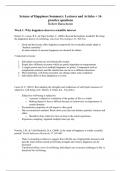Samenvatting
Summary / Samenvatting for Science Of Happiness - Lectures, Articles and 16 practice questions (2024)
- Instelling
- Universiteit Utrecht (UU)
This is my summary for science of happiness. This includes all the lectures and the articles. All articles are summarized shortly. At the end there are 16 practice questions (2 for each week) with answers and explanations. The practice questions are also available on Stuvia. Dit is mijn samenva...
[Meer zien]




